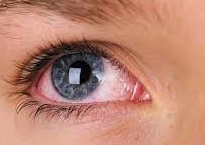A large number of studies, both in vitro and in vivo, have demonstrated the beneficial effect that nutrition can have on maintaining general wellbeing conditions throughout the body.
In particular, recent studies have reported how some dietary componentswhich can be taken with food or through supplements, can affect the health of the ocular surface.
Indeed, there is much evidence to support the possible role of various micronutrients and nutraceuticals in the treatment of ocular surface diseases.
Ocular surface and dry eye syndrome
The ocular surface is a delicately balanced system, made up of various components, interconnected both structurally and functionally.
Structure
The ocular surface includes the cornea, conjunctiva and ocular adnexa such as the eyelids, eyelashes, tear film, main and accessory lacrimal glands and meibomian glands.
The set of structures that make up the ocular surface system participate in the production and distribution of the tear film on the anterior surface of the eye.
The structures that contribute to the production of the tear film include:
- the main and accessory lacrimal glands,
- the mucipar calycephalic cells of the conjunctiva
- the Meibomian glands
The distribution and excretion of the tear film are ensured by the aeyelid crinkling.
The secretory activity of the glands is finely organised thanks to the control exerted by the nervous system, the endocrine system (thanks to sex hormones and, above all, testosterone, which has a trophic effect on the glands) and the immune system, which regulates the inflammatory response and the reaction against possible infectious agents.
Functions
The ocular surface represents a direct connection between the eye and the external environment and, therefore, all its components act synergistically to keep the eye healthy and protect key structures of vision from external pathogens. Both of these goals are achieved, inter alia, through the production of an efficient tear film.
Any factor that disrupts thehomeostasis of the ocular surface system can alter the stability and osmolarity of tears, leading to tissue damage through osmotic, mechanical and inflammatory processes.
Dry eye syndrome
One of the conditions in which ocular surface homeostasis is altered is dry eye syndrome, a multifactorial ocular surface disease that affects up to 30% of individuals over the age of 50. A higher incidence has been found in older people, postmenopausal women, contact lens wearers and patients with autoimmune diseases.
 Type of dry eye
Type of dry eye
Dry eye syndrome can be due to decreased tear production or increased evaporation. Both of these conditions lead to hyperosmolarity and subsequent inflammation of the ocular surface.
Hyposecretion
Hyposecretory forms, in which there is a reduced functioning of the lacrimal glands, include forms related to autoimmune diseases, such as primarily Sjögren's syndrome, but also rheumatoid arthritis, systemic lupus erythematosus, polyarthritis nodosa, Wegener's granulomatosis, systemic sclerosis and other connective tissue diseases.
Then there are the hyposecretive 'non-Sjögren' forms of dry eye, the most important of which is age-related.
Excess evaporation
Dry eye due to excess evaporation can be classified according to the conditions that cause it, into 'intrinsic' (e.g. in case of Meibomian gland dysfunction or eyelid and orbital abnormalities) and 'extrinsic' (due to contact lens use or topical drugs with preservatives; eye diseases such as allergy and conjunctivitis; vitamin A deficiency).
Symptoms of dry eye syndrome, such as blurred vision, photo-sensitivity, irritation, burning and itching, can limit daily activities and have a negative impact on quality of life.
Risk factors
The main risk factors can be summarised as follows:
1. Age: ageing causes progressive atrophy of the lacrimal glands.
2. Gender: women between 40 and 60 are more affected by dry eye, probably due to the new hormonal balance following the menopause.
3. Use of certain drugs: hormones, immunosuppressants, antihypertensives, antihistamines, antidepressants and others.
4. Climatic-environmental factors: air conditioning, dry climate, cigarette smoke, wind, smog.
5. Prolonged use of computers and television.
6. Nutritional deficiencies: insufficient vitamin A intake.
7. Contact lens wear. The use of all types of contact lenses has been found to result in changes to the ocular surface and tear film. The magnitude of these effects varies depending on the lens material, how they are worn and the characteristics of the wearer. Silicone hydrogel lenses generally cause fewer harmful effects. However, the risk of corneal infection and inflammation remains high, especially in the case of recurrent night-time lens wear. In the case of predominantly daytime use, damage to the ocular surface may also result from the use of certain solutions for daily lens cleaning, to which the eye can be or become particularly sensitive.
Feeding and essential fatty acids in ocular surface health
Strong scientific evidence demonstrates the efficacy of omega-3 fatty acid intake, either through diet or supplements, in improving the symptoms of dry eye syndrome, a condition of growing concern. and ocular surface health.
One of the first clinical trials came from a large cross-sectional study involving over 30,000 women that demonstrated a relationship between a low dietary intake of omega-3 fatty acids and an increased risk of dry eye syndrome.
Omega-3s are key structural components of cell membranes and precursors for the synthesis of numerous biologically active substances.
The main omega-3 fatty acids include short-chain alpha-linoleic acid and long-chain eicosapentaenoic acid, docosapentaenoic acid and docosahexanoic acid. While short-chain omega-3 fatty acids are obtained from plant sources, long-chain omega-3 fatty acids are obtained from oily fish and can be synthesised by elongating short-chain fatty acids. Omega-3s exhibit anti-inflammatory properties that they exert through competitive inhibition with arachidonic acid as a substrate for the enzymes cyclooxygenase and 5-lipoxygenase.
It has been reported that omega-3 fatty acids may also have a neuroprotective effect, which is of great clinical interest to ophthalmologists.
Indeed, the corneal nerves are essential for tear production, for the protective blink reflex and for the release of trophic neuromodulators that maintain the vitality and metabolism of ocular surface tissues.
Nutrition and vitamins in ocular surface health
 Vitamin A
Vitamin A
The term vitamin A includes retinol, the most biologically active form, of animal origin, and carotenoids, precursors found in a wide variety of fruits and vegetables. Vitamin A is necessary for a whole range of functions and, in the eye, for mucosal health, retinal phototransduction, metabolism, growth and differentiation of the ocular surface epithelium. In fact, vitamin A deficiency, due to malnutrition, is a major cause of blindness in developing countries. A recent clinical study has shown that taking vitamin A, either through diet or supplements, improves tear quality in patients with dry eye syndrome, promoting ocular surface health.
Vitamin B-12
Vitamin B12 is a cofactor in DNA synthesis and is involved in the metabolism of fatty acids and amino acids. It is found in animal products including meat, milk, eggs, fish and shellfish. This micronutrient plays a key role in myelin synthesis and its deficiency is associated with myelopathy, peripheral neuropathy, neuropsychiatric syndromes and optic atrophy. In recent years, the role of neurosensory abnormalities in the pathophysiology of dry eye syndrome has been recognised, and two recent studies have demonstrated an improvement in symptoms in patients with a severe form following vitamin B12 supplementation in the form of eye drops.
Vitamin C
Vitamin C is a water-soluble vitamin required for the functioning of a wide range of enzymes and is found in fruits and vegetables such as citrus fruits, strawberries, cherries, tomatoes and broccoli. The tear film contains high levels of vitamin C, reflecting the high demand for this nutrient by the ocular surface for antioxidant defence. In addition, vitamin C appears to play an important role in corneal wound healing processes.
Vitamin D
Vitamin D is a fat-soluble vitamin that can be acquired through specific food intake or produced in the skin following exposure to sunlight. Vitamin D deficiency has recently been associated with the pathogenesis of dry eye syndrome. Indeed, vitamin D plays an immunomodulatory role and regulates cell proliferation, differentiation and apoptosis, thus enhancing the corneal epithelial barrier. Moreover, by promoting surfactant production, it increases the lipid component of the tear film. Finally, it modulates systemic calcium absorption, which plays a crucial role in maintaining fluid secretion from the lacrimal glands. Serum vitamin D levels have shown significant correlations with tear production and dry eye syndrome symptoms. For all these reasons, vitamin D has been investigated as a potential therapy for this condition.
Nutrition and other micro-nutrients
Selenium and lactoferrin
Selenium is an essential micronutrient that emphasises the importance of nutrition for ocular health. found mainly in meat, fish, seafood and cereals. The human body contains several selenoproteins, which are essential for development and metabolism.
In particular, glutathione peroxidase protects cells from oxidative stress and its expression is reduced in patients with dry eye syndrome. In contrast, selenoprotein P is a selenium transport protein produced by the lacrimal gland and secreted in tears to supply selenium to the corneal epithelium.
In dry eye syndrome, levels of selenoprotein P in the tears are also reduced.
Lactoferrin is an iron-binding glycoprotein present in most exocrine fluids, including tears, which serves to protect the corneal epithelium from ultraviolet irradiation.
Lactoferrin concentration has also been found to be reduced in dry eye syndrome, and oral supplementation in patients results in significant improvement of symptoms.
Curcumin
Curcumin is a polyphenol isolated from Curcuma longa, which is widely used as a spice. It is known to have anti-inflammatory, antioxidant, anti-angiogenic, healing and antimicrobial properties.
Curcumin helps restore ocular surface homeostasis by reducing reactive oxygen species, decreasing the expression of inflammation mediators and increasing neurotrophic factors.
Therefore, studies have identified curcumin as a promising candidate for the treatment of dry eye syndrome.

